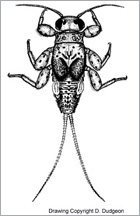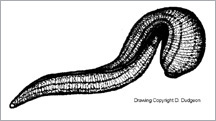6.4 INVERTEBRATES
Molluscs / Crustacea / Insects
 The
invertebrates comprise a large number of groups – making up most of the
animal species – and are united by the fact that they lack a backbone.
They range from a rather simple degree of organization – as in the flatworms – to the highly complex organs, structures and behaviours seen in the insects.
This section includes only those groups that are diverse in rivers, or
especially relevant to river ecology. Detailed information on these and
other groups, as well as identification keys to families or genera, are
provided by Dudgeon (1999). Discussion is confined to macroinvertebrates
defined broadly as animals with body length > 0.5 mm which would be
retained by a collecting net of 200 microns mesh size. They can be divided
informally into two groups: the lower and the higher invertebrates. The
category 'lower invertebrates' includes all invertebrates except molluscs
and arthropods (such as insects and crustaceans), and contains fewer species
than the 'higher' grouping.
The
invertebrates comprise a large number of groups – making up most of the
animal species – and are united by the fact that they lack a backbone.
They range from a rather simple degree of organization – as in the flatworms – to the highly complex organs, structures and behaviours seen in the insects.
This section includes only those groups that are diverse in rivers, or
especially relevant to river ecology. Detailed information on these and
other groups, as well as identification keys to families or genera, are
provided by Dudgeon (1999). Discussion is confined to macroinvertebrates
defined broadly as animals with body length > 0.5 mm which would be
retained by a collecting net of 200 microns mesh size. They can be divided
informally into two groups: the lower and the higher invertebrates. The
category 'lower invertebrates' includes all invertebrates except molluscs
and arthropods (such as insects and crustaceans), and contains fewer species
than the 'higher' grouping.
Lower invertebrates
This category of animals includes creatures that encrust hard surfaces
and may have a  rather
amorphous shape, tiny planktonic rotifers, jelly-like coelenterates, and
a wide range of flat and round-bodied organisms grouped together under
the category of 'worms'. Sponges (phylum Porifera) and moss animals (phylum
Polyzoa or Ectoprocta) are encrusting forms that are of very minor ecological
importance in rivers (although they may foul water-supply pipes), as are
the rotifers and coelenterates, while the worms are a large and varied
group. Among them, the flatworms, nematodes and the annelids are of some
ecological significance in rivers.
rather
amorphous shape, tiny planktonic rotifers, jelly-like coelenterates, and
a wide range of flat and round-bodied organisms grouped together under
the category of 'worms'. Sponges (phylum Porifera) and moss animals (phylum
Polyzoa or Ectoprocta) are encrusting forms that are of very minor ecological
importance in rivers (although they may foul water-supply pipes), as are
the rotifers and coelenterates, while the worms are a large and varied
group. Among them, the flatworms, nematodes and the annelids are of some
ecological significance in rivers.
Flatworms
The Turbellaria or flatworms are the only non-parasitic class in the phylum
Platyhelminthes (which also includes the flukes and tapeworms: Trematoda
and Cestoidea). Species of Dugesia (Dugesiidae) are found most
frequently underneath stones in upland streams, but Planaria (Planariidae)
also occurs in Asian rivers; members of both genera are predators or eat
carrion.
Nematodes
Nematodes (or roundworms) are among the most numerous and diverse group
of organisms on earth. Many are parasites of great economic importance,
and members of this phylum inhabit almost all types of environment. They
are likely to be abundant among mud and find sand deposits on riverbeds.
Most free-living freshwater nematodes are small (<10 mm long) and,
because they are thin, tend to pass through the mesh of all but the finest
collecting nets. Consequently, little can be stated with confidence about
their distribution, abundance and ecological importance in tropical Asian
rivers.
Annelids
The segmented worms (phylum Annelida) have three freshwater classes: the
Oligochaeta, the Polychaeta, and the leeches. The oligochaetes have bundles
of fine bristles on most segments but, in general, the body has no other
projections or appendages and most of them (apart from the family Naididae)
lack eyes. Compared to the familiar earthworm, most freshwater oligochaetes
are small (<30 mm long) and delicate with thin, almost transparent,
body walls. Gaseous exchange occurs through the body surface in all species.
In oligochaetes that live in oxygen-poor environments, including polluted
rivers, oxygen uptake is enhanced by haemoglobin in the 'blood' and/or
external gills at the end of the body. Tropical Asia has about 170 species
of freshwater oligochaetes, mainly Tubificidae (that may be abundant in
polluted sites) and numerous naidids. All burrow into the bottom sediments
of rivers, where they feed on deposited organic matter.
Most polychaetes are marine animals but some species in the families Nereidae
and Nephtyidae live in rivers. Typically they occur in the lower course,
especially close to the coast, and they may be quite tolerant of pollution.
Polychaetes are distinguished from other annelids by the presence of paired,
paddle-like structures (called parapodia) on most of the body segments,
and tentacles on the head. In addition, because they are predators, the
jaws are well developed.
Leeches (class Hirudinea) can be distinguished easily from other annelids
by the presence of an anterior and a posterior sucker. The mouth and jaws
are situated in the anterior sucker. Most leeches are flattened. Locomotion
is by swimming or, more commonly, by 'looping' using a combination of
the body muscles and the two suckers. Leeches occur in a range of rivers
habitats, but are more diverse in slow-flowing or standing waters. Some
of them are blood-feeding ectoparasites of mammals (including humans),
while others specialize upon the blood of fish, amphibians, terrapins
or waterfowl. The duration of feeding on the host is typically rather
short, and the majority of ectoparasitic leeches spent much of their time
living away from their host. Predation upon other invertebrates (especially
oligochaetes and snails) – and not blood-feeding – is very common
among leeches, as in the diverse families Glossiphoniidae and Erpobdellidae.